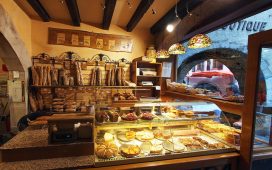The world of French pastries is a symphony of delicate layers, exquisite fillings, and unparalleled craftsmanship. Elevate your baking skills to a new level by mastering the art of iconic French pastries such as croissants and eclairs. In this guide, we’ll embark on a culinary journey through the techniques and secrets that make these delectable treats a staple in patisseries around the world.
1. Classic Croissants: The Art of Layering
Ingredients:
- 1 1/4 cups warm milk
- 2 tablespoons active dry yeast
- 1/4 cup granulated sugar
- 3 1/4 cups all-purpose flour
- 1 teaspoon salt
- 1 1/4 cups unsalted butter, cold
Technique:
- Activate yeast by dissolving it in warm milk with a pinch of sugar. Let it sit until frothy.
- In a large bowl, combine flour, sugar, and salt. Make a well in the center and pour in the yeast mixture.
- Knead the dough until smooth and refrigerate for 30 minutes.
- Roll out the dough into a rectangle and place the cold butter in the center.
- Fold the dough over the butter, creating layers. Repeat the folding process multiple times.
- Chill the dough, then roll, cut, shape, and proof before baking.
2. Decadent Eclairs: A Pâte à Choux Masterpiece
Ingredients:
- 1 cup water
- 1/2 cup unsalted butter
- 1 cup all-purpose flour
- 4 large eggs
- Pinch of salt
- Whipped cream or pastry cream for filling
Technique:
- In a saucepan, combine water, butter, and salt. Bring to a boil.
- Add flour and stir vigorously until the mixture forms a ball.
- Transfer the dough to a mixing bowl and let it cool slightly.
- Gradually add eggs, one at a time, beating well after each addition.
- Pipe the dough into eclair shapes on a baking sheet.
- Bake until golden, then let them cool before filling with whipped cream or pastry cream.
3. Perfect Pâte Brisée: The Foundation of Tarts
Ingredients:
- 1 1/4 cups all-purpose flour
- 1/2 cup unsalted butter, cold and cubed
- 1/4 cup ice water
- 1/2 teaspoon salt
Technique:
- Combine flour and salt in a food processor. Add cold, cubed butter and pulse until the mixture resembles coarse crumbs.
- Gradually add ice water while pulsing until the dough starts to come together.
- Turn the dough out onto a floured surface and form it into a disc.
- Wrap in plastic wrap and refrigerate for at least 1 hour.
- Roll out the chilled dough and use it as a base for various French tarts.
4. Velvety Crème Pâtissière: The Soul of Pastries
Ingredients:
- 2 cups whole milk
- 1 vanilla bean, split lengthwise
- 6 large egg yolks
- 1/2 cup granulated sugar
- 1/3 cup cornstarch
Technique:
- In a saucepan, heat milk and the scraped seeds from the vanilla bean until just simmering.
- In a bowl, whisk together egg yolks, sugar, and cornstarch until smooth.
- Slowly pour the hot milk over the egg mixture, whisking continuously.
- Return the mixture to the saucepan and cook over medium heat until thickened.
- Strain the custard through a fine-mesh sieve and let it cool before using as a filling for eclairs, tarts, or other pastries.
5. Tips for Success:
- Cold Butter is Key: Ensure your butter is cold when making laminated dough like croissants to achieve those flaky layers.
- Precision in Piping: Use a piping bag for precision when shaping eclairs and tarts, ensuring even sizes and uniform baking.
- Patience with Proofing: Allow your dough to properly proof. This step is crucial for achieving the right texture and flavor in your pastries.
- Quality Ingredients: Use high-quality ingredients, especially when making fillings like crème pâtissière, for an authentic and delicious taste.
Embark on your French pastry adventure with these techniques, and soon you’ll be creating a symphony of flavors and textures that rival the finest patisseries in Paris. With practice and a touch of artistry, you’ll master the art of crafting these classic French pastries, turning every bite into a heavenly experience.







